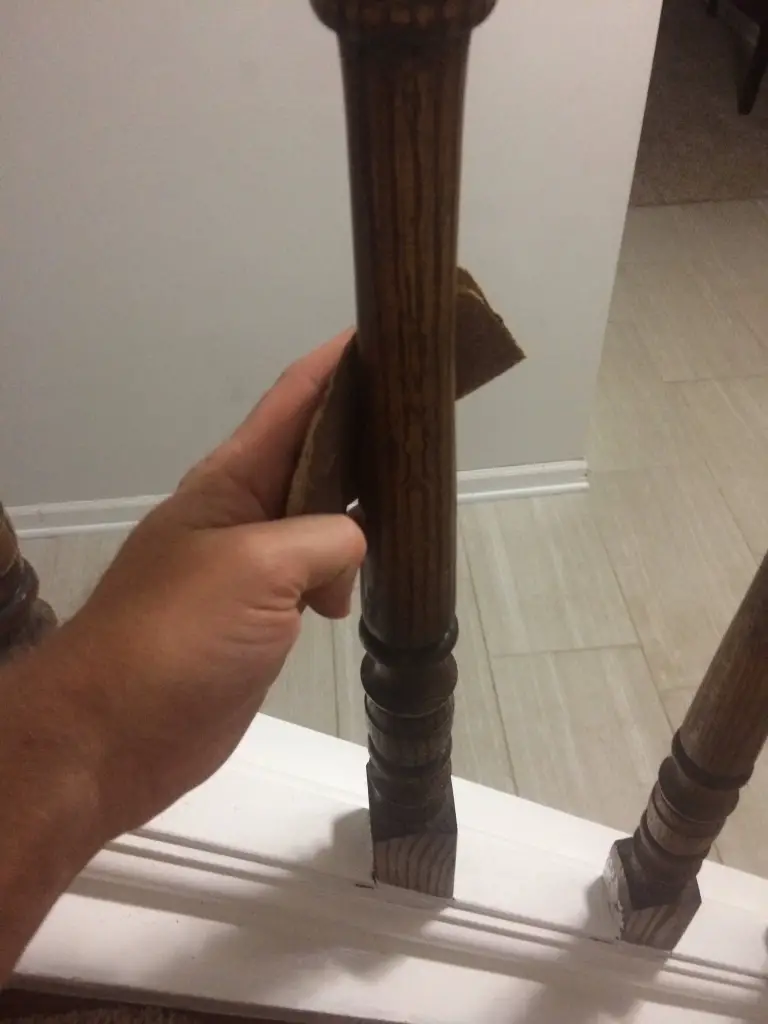Staining is one long-drawn process. From sanding to coating to priming and then drying, there is a lot that the woodworker has to cope with. Changing the wood stain color is a different ball game, requiring thorough knowledge.

Here is what I found:
How to Change Wood Stain Color on Furniture, Door?
You can change the color of stained wood, from dark to light, or light to dark, by sanding and re-staining. Re-staining can give the furniture a new style and look. You can also get the color you want by mixing the base stain colors, but be sure to test it before staining.
Is it as simple here? Yes. Does each technique require some skills and tools? Absolutely! What other things must you know? This article details everything.
Keep reading!
Table of Contents
4 Ways to Change Wood Stain Color
Sand off The Stained Wood Pieces
You’re cool with the color of your stained wood piece? Then, try to sand down the wood. Sanding is the easiest and most conventional technique to change the wood’s coloring, mainly if your wood is flat. But you’ll need an orbital sander to do an excellent job.
Start by sanding with low-grit sandpaper, maybe 60-grit. Upgrade to 80-grit sandpaper but first highlight a light line on the piece with a pencil. Repeat the technique until you’ve sanded all the sections of the surface up with240-grit sandpaper. You should have a smooth and even wood surface by the time you’re gone up to 240-grit.

Fix Your Wood Stain with Bleach
To start with, ensure your stained wood is completely dried before bleaching. A 24 to 48-hour wait won’t be a bad idea. Apply laundry bleach or chlorine to remove or change the wood stain color. Chlorine is perfect for changing dye-based stains. But it’ll not remove pigment-based stains.
It is better to apply bleach with a sponge. You can use a spray bottle. But first, test the formula on a new wood piece. Once you apply it to your project, allow the solution to sit for a few minutes before adding water. Use a rag to dry the towel and allow the wood to dry for 24-48 hours before top-coating or re-coating it. Note that bleaches aren’t ideal for previously top-coated wood.
Paint over Stain
To change the color of the wood stain, you can also paint over the stain. Painting the stained wood piece is another technique you can use if all other methods don’t work out. You can paint the entire stained wood piece. You can also opt for a two-toned piece in which case you’ll only sand the difficult-to-reach areas of the wood. Once you have painted and sanded down these areas, you will get back the desired look for your wood. Never waste your time on the time-consuming sections of the wood.
Stain over Stain
Another trick you can apply to fix a poor wood color is to stain over the previous stain. Staining over the finish works best even if you’ve finished your wood piece with a topcoat. Simply color the finish with a more elegantly-looking stain. But remember, you can only apply a darker color stain as it only sits on top of the finish and won’t penetrate. You can use a mixture of polyurethane and stain or gel stain. Gel stain works as a tinting stain for the finished and unfinished wood.
Start by sanding the piece with fine-grit sandpaper before applying the gel stain with a towel or rag. Make each coat light to avoid obscuring the wood.
Change Colour of Stained Wood
Dark Wood Stains to Light Color
The first step to make your dark-stained wood lighter is to strip the wood piece of its previous dark stain and finish. After stripping the existing stain, put petroleum-based solvent, turpentine, or mineral spirit inside a bowl.
Get a clean rag or cloth and soak it in the formula. Rub the soaked cloth along the direction of the wood grain. Allow the surface to dry out completely before sanding, remove the sanding dust, and refinish. Don’t forget, the solvent will only lighten the dark stain on the wood and not remove it.
Read More >> How To Stain Wood Darker Color? [3 Ways, 7 Tips, 10 Best]
Light Wood Stains to Dark Color?
There are three steps to get your light wood darkened:
Step 1: First, you need to thoroughly sand the wood so it can grip the new darker stain. But remember to fine sand with 150-grit so that the scratches will not be too revealing.
Step 2: Secondly, increase the color-magnitude of the binder and thinner so that the newly introduced color gets darker as they increase in magnitude.
Step 3: Do not wipe off all the excess dust on the wood surface. Rather, leave some wet stain on the wood to give a darker coloring when it dries up.
Read More >> How To Lighten Dark Stained Wood Furniture? – Bleaching And Sanding
How to Re-stain Furniture Darker without Sanding?
Applying stain to a stained wood without sanding is a simple process. It involves using a top-quality gel stain to cover the old or existing stain. Using this measure doesn’t require you to sand the surface.
Testing the new stain on different wood is always advisable before applying the stain to the project to be re-stained. This way, you can second-guess the outcome.
After that, you can use very smooth sandpaper to eliminate a few scuffs so the stain can adhere to the wood. You can mix two or three stains to achieve your desired stain color.
How to Change The Stain Color on Old Wood Furniture, Floors?
There are two methods for doing this;
First, completely wipe off the old finish by sanding. After that, choose a wood stain that will either help change the wood color or defeat the idea. Then, apply the new stain. Then, examine the wood specie to see if you can achieve the expected result.
The second method involves bleaching the wood to change its color. This method is very useful on both raw and painted wood. If you are working on stained wood, bleach will help to strip off the finish but may not change the wood tone.
How to Recolor with Darker Stain While Retaining Wood Look?
Doing an excellent recoloring job on your stained wood requires some tact.
You start by choosing gel stain. Apply the gel or oil-based stain to the existing stain on the wood. Gel stain is different from the regular traditional stain because it doesn’t necessarily need to permeate through the wood.
Instead, it just catches on the wood and forms a transparent layer. This method will help retain the wood look and requires little effort from staining woodwork.
Custom color, dark brown, and ebony are the three darkest wood stain colors you can work with. If you’re looking for a genuinely black stain, oil-based or gel paint will also work.
Mix Satin Colors
What Happens If You Stain over Stain?
The idea behind staining over stain is to give a lighter and more elegant color to your existing stained wood piece. Re-staining helps freshen up your off-color old project, giving it a new style and look.
Apart from the aesthetics, applying stains over stain helps prevent your wood project from rotting and rusting.
Usually, once it’s exposed to the air and UV rays from sun, stained wood becomes vulnerable and weak to withstand the severe threats from the elements. As I mentioned earlier, staining over existing stains is pretty straightforward. This is so especially if you’re applying a dark stain over a previously white stained wood.
Can You Layer Different Stain Colors?
You can layer different stain colors. The idea is to change the appearance of the wood and restore it to life.
In addition, layering on several coats of stains in different colors helps to hide a surface imperfection, including sapwood streaks and strokes.
Plus, it offers the color depth, although you will be able to see the last stain color. The stain color on top obscures the color beneath it, but all colors combine and blend to give a shade of aesthetically different color hues and tints. The good thing is that layering in different stain colors is simple and effective.
How to Mix Stain to Get Custom Colors?
In a fix to find the right stain color? You can easily match and mix wood stains to get customer colors.
Here’s how to do:
- Supplies needed: a plastic can, a small cup, a pair of nylon or latex gloves, a stirrer, and scrap wood.
- Figure out the original or base colors of your wood.
- Mix base stain colors and other colors in separate small cans to coordinate and mix the two colors in a bigger container. Start with ratio 4:1, 4:2, 4:3, and so on.
- Apply stains on scrap wood: apply the stain on the scrap wood with a brush or rag.
- Wipe off the stain
- Continue to add the small color if you’re satisfied with the mixture.
Avoid Wrong Wood Stain Color at the Beginning of the Woodworking Project
When applying stain color to your project, you must avoid using the wrong wood stain color. To do this, test the stain color first on a piece of scrap wood before applying it to the project. Do the same thing for the finish: test it first on a plank of scrap wood. Once the color you’re starting with is right, there’s a possibility your project won’t come out as a failure.
However, if you’re finishing wood furniture, it is best to test the finish and stain color on the bark of a tabletop. Sometimes, it is too red, ebony, dark, or light. There are things you must do to fix a poor wood stain color.
Getting a darker stain is the best and first thing to do. Apply to the top of the existing stain a darker stain. You can sand down the wood piece before re-staining if you don’t want your wood piece to have a darker shade.
How to Choose the Right Wood Stain Color?
Choosing the right wood stain involves considering a lot of factors, such as the type of wood, the number of stain coats, and lighting. Before you choose your preferred type of color, you will need to examine how the stain will react to the specie of wood you have. Note that some stains bring out the natural features of the wood while other types of stains maintain the normal tone. For instance, water-based stains bring out the wood grain color, while oil-based stains permeate deeper into the wood, giving it a darker color.
Most outdoor stains contain acrylic, and they come in different colors and even stick on the wood differently. In choosing the right wood stain color, you should consider the location. For instance, deck wood paint is expected to be water-resistant to avoid cracking or warping.
Also, you should assess your stain color under different types of lighting. Truth is, stains do change looks depending on the lighting conditions. It is observed that normal bulbs have a warm effect on the wood stain than a fluorescent. You need to check where the sun is intense on the wood you’re working on, as natural light can change its appearance.
FAQs
Does Wood Stain Change Color When Drying?
The direct answer is ‘Yes’. Wood will change color when drying. Applying the first stain to the wood will look much lighter than when it dries, which can mislead you into applying more coats to make the stain darker in color. Then when it finally dries, it might become darker than you expected.
Does Wood Stain Change Color over Time?
Yes. The stain will fade away if a stained wood is exposed to air, UV rays from sunlight, or harsh weather conditions for a long time. Nonetheless, the stain’s original color will remain. The result is a changed color in the wood.
What Is The Most Popular Wood Stain Color?
At the moment, Jacobean is seen as the most popular wood stain color. This idea was discovered when woodworkers fond of testing a mixture of Jacobean and Ebony found that the color gets darker when the wood dries. The combo, popularly called expresso, gives an excellent darker look to the wood.
Will Stain Look Different on Different Woods?
The range of reactions of stains to different wood types differs. You may be surprised to see that the same piece of wood can have different tints and hues. You can only use your choice of stain colors alongside thinners to adjust the stain on any wood.
Final Words
Changing the wood color of existing stained wood is effortless. It requires someone who understands the job, and woodworkers must get familiar with the different stain types. Gel stains come as the best choice formula to use.
In addition to ebony, custom colors, and dark brown, there is a wide range of stain colors. Ultimately, what matters is the color and look you prefer. However, the varying the colors, your project’s highly aesthetic will look like. It’s best to use the best colors, It doesn’t matter if you want your stained wood dark or light.

My name is Mark, and I am a software engineer and the founder of OnWoodWorkingArt.
I grew up with a passion for woodworking and now have my woodworking studio with a group of like-minded friends who love to create woodworking. My dream is to have a more extensive workshop and be able to make woodworking my main business.